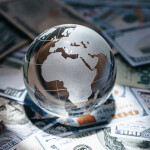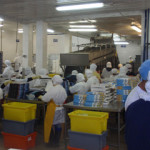In spite of the tough economic backdrop, Europe’s seafood industry continued to enthrall and excite us in 2012. So as the year which brought the inaugural Seafood Barcelona show as well as the 20th edition of the European Seafood Exposition (ESE) draws to a close, we take a look back at 10 stories that defined the sector.
10) The world’s first Aquaculture Stewardship Council (ASC)-certified pangasius product was sold at a branch of Dirk van den Broek supermarkets in the Netherlands on 21 September after the first ASC certificate for pangasius was awarded to Vietnamese producer Vinh Hoan 10 days earlier. Pangasius is one of the most commonly eaten fish in the Netherlands and many other European countries. But while the EU was accounting for as much as 40 percent of Vietnam’s pangasius exports at the start of 2012, demand has steadily declined over the course of the year. ASC unveiled its consumer-facing label in April this year.
9) The Mediterranean seabass and seabream farming industry continued to defy the tough economic situation in southern Europe throughout 2012. As well as keeping a close check on production levels, the sector was buoyed by the growing popularity of bass and bream in non-traditional markets, most notably northern Europe, Russia, the United States and the Middle East. Producers have also been eyeing the long-term potential of China and Brazil. Greece is the world’s No. 1 producer of bass and bream – the sector contributes around EUR 400 million (USD 529.2 million) to the country’s economy. But neighboring Turkey has also been ramping up its production and could rival Greece for the top spot by the end of the decade. The Turkish aquaculture sector was expected to produce 100,000 metric tons this year.
8) Morrisons, the United Kingdom’s fourth largest retailer, set about overhauling its seafood supply chain in the early part of the year. In launching its own processing operation in Grimsby, it brought 200 new jobs to the port. The supermarket chain, which expects to produce 10,000 metric tons of fresh and frozen seafood at the site annually once it’s fully up and running, also became the country’s only major retailer to source fish direct from the quayside.
7) 2013 is set to be a a big year for cod after the total quota for North East Arctic cod in the Barents Sea for the coming year was confirmed by the Joint Norwegian-Russian Fisheries Commission at 1 million metric tons, an increase of 249,000 metric tons or 33 percent from this year. At the same time, Iceland’s cod catch for the 2013/2013 season was set at 196,000 metric tons, an increase of 22.5 percent. While the proposed cod increases are positive news for fisheries management, there are fears about what effect the significantly greater catch will have on prices, especially as the increased supply comes at a time when important markets like Spain and Portugal are economically weak. Furthermore, both fisheries have seen their haddock quotas slashed – by 41 percent to 200,000 metric tons in the Barents Sea and by 36 percent to 32,000 metric tons for Iceland.
6) The largest aquaculture plant in Europe opened in Poland in September. Operated by AquaMaof Aquaculture Technologies, the EUR 12 million (USD 15.9 million) 8,000 square meter facility will yield 1,200 metric tons of tilapia annually. Israeli company AquaMaof specializes in erecting and managing industrialized fish farming facilities around the world. It has developed patent-protected technology that makes it possible to breed fish under controlled temperature conditions in all types of weather, in any country and during all seasons, independently of external factors. Although this means breeding under cover in tanks, an additional patent makes it possible to save more than 70 percent of the energy and manpower as compared to other breeding facilities. AquaMaof has several other projects in development, including one to produce 500 metric tons of trout annually at a location near Moscow and another in Romania for breeding sturgeon for caviar production. The cost of building each fish farm ranges from EUR 4 million (USD 5.3 million) to EUR 150 million (USD 198.5 million).
5) 2012 was the year that bluefin tuna stocks started to bounce back. As a result, a total allowable catch (TAC) of 13,400 metric tons was set for the Eastern Atlantic and Mediterranean Sea for 2013, up from 12,900 metric tons in the past three years. Environmental groups applauded the decision by the International Commission for the Conservation of Atlantic Tunas (ICCAT) to not get carried away with the good news and to set a modest and acceptable quota increase.
4) The Marine Stewardship Council (MSC) carried through with its vow to suspend certification of the mackerel fisheries in the North East Atlantic. The suspension, which followed two years of catches well above the scientific advice, meant all mackerel caught after 30 March was ineligible to be labeled as certified. The International Council for the Exploration of the Sea (ICES) recommended a mackerel total allowable catch (TAC) of 639,000 metric tons for the 2012 season, but after the coastal states failed to broker a deal, it was believed the combined North East Atlantic fleets would end up catching near to 900,000 metric tons. In September, a vote in the European Parliament approved plans to make sanction measures available to the EU for use against states that pursue unsustainable fishing practices outside international agreements, such as Iceland and the Faroes. Pressure has been mounting ever since on the EU, particularly from the United Kingdom, to exercise these new powers to try to force an agreement.
3) In July, private equity firm Permira Advisers LLP called off the sale of Iglo Foods Group Ltd., which includes the Birds Eye brand in the United Kingdom, after failing to receive an acceptable bid. It was reported that Blackstone Group LP and BC Partners Ltd. submitted an offer of EUR 2.5 billion (USD 3.3 billion) in June that didn’t meet Permira’s target of EUR 2.8 billion (USD 3.7 billion) to EUR 3 billion (USD 4 billion). Just days after rejecting the bid, the firm had lined up a dividend recapitalization with Credit Suisse and Deutsche Bank. Permira then changed its mind and opted not to pursue the plan after it was unable to reach the level of dividend payout it wanted. Permira purchased Iglo from Unilever NV in 2006 for EUR 1.7 billion (USD 2.3 billion), and expanded it after buying Unilever’s Findus business in Italy for EUR 805 million (USD 1.1 billion) four years later.
?2) In adhering to the strict sourcing policies of the 2012 Olympic and Paralympic Games, U.K. caterers gave a massive shot in the arm to the sustainable seafood movement. Over a total of 27 days of sporting action, an estimated 14 million meals were consumed at the various Olympic venues, including 1.2 million meals by the athletes, and every seafood product used – an estimated 100 metric tons – was assessed by the London Organizing Committee of the 2012 Olympic and Paralympic Games (LOCOG) and confirmed as being sustainable. The 2012 Games are now being hailed as something of a game-changer for seafood supplies for the country as a whole as many foodservice companies have since pledged to continue their commitment to sustainable fish procurement.
1) Following a marathon voting session earlier this month, the European Parliament Fisheries Committee finally passed the first reading of the bill to reform the Common Fisheries Policy (CFP). The bill will now go to the full parliament for a vote in February 2013. On the high profile issue of discards, the committee emphasized the need to help fishermen avoid unwanted by-catch through mechanisms like financing special fishing gear and introduced new rules around discard limits. The committee also dismissed plans for Transferable Fisheries Concessions (TFCs), although member states may introduce a system of temporary transfers within their own zones. Member states will also be able to adopt and implement their own day-to-day fisheries management plans within a general framework set by the Commission and subject to consultation with the scientists, though the Commission retain the right to claw back control if they don't like what a member state is doing, or if it fails to enforce management and conservation controls. Finally, the committee agreed to set conservation and sustainable catch targets above the Maximum Sustainable Yield (MSY) limits for all quota stocks by 2020 at the latest.






